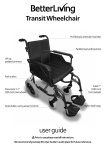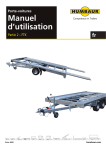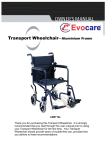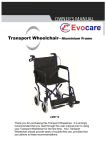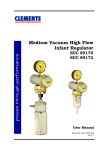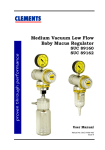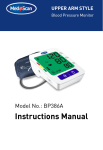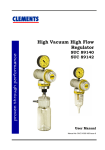Download Standard Wheelchair user guide
Transcript
Standard Wheelchair Profiled grip attendant handles Detachable, height adjustable padded armrests Padded backrest Grip rings Park brakes Quick release 24” (610 mm) rear drive wheels Nylon heel loops Detachable, swing away footrests user guide Prior to use please read all instructions. We recommend you keep this User Guide in a safe place for future reference. Novis Standard Wheelchair Product Overview Box Contents and Inspection An economical self propelled wheelchair that is easy to manoeuvre, fold, transport and carry. Lightweight non-corroding aluminium frame equipped with comfortable profiled grip handles, detachable height adjustable padded armrests, sturdy park brakes and anti-tip wheels for added safety. Carefully remove all components from the box and check items against the list below. Any damaged or missing components should be reported to your authorised dealer or Novis Healthcare. Prior to use, remove all packaging and plastic wrapping and check the wheelchair for any damage that may have occurred in transit, paying particular attention to: The detachable, height adjustable footrests are equipped with heel loops, offering greater security and user comfort. Both footrests fold away to increase accessibility and ease of transfer. The chair is simple to fold for easy travel and storage. ›› Any cracks or damage to the wheels, tyres or chassis. ›› Damage to the seat and backrest. ›› Any missing or loose screws, wheelnuts or fasteners. Intended Use ›› This wheelchair is designed for indoor and outdoor use, and is intended for either self propulsion or propulsion by an attendant. ›› The maximum user weight is 110 kilograms, as stated on the manufacturer’s label. ›› The wheelchair should only be used and maintained in accordance with the instructions in this User Guide. Wheelchair User Guide (this document) Left hand footrest Tool kit Right hand footrest 2 Set Up Unfold the wheelchair To unfold the wheelchair, place on a stable surface and stand behind the wheelchair. Use both hands to press down on the outer edges of the seat frame to unfold. It may help to gently tilt the wheelchair back to lift the front wheels off the floor. Once open, press firmly to make sure cross brace is locked. Attach the footrests With the footrest at a 90 angle to the chassis (ie swung outwards to ensure the semi circle recess on the footrest bracket fits around the leg post), attach the footrest by aligning and dropping the hinge at the top of each footrest into the hole in the top of the chassis leg section. Now swivel the footrest inward to lock into position and fold down the footplates. 3 Adjustments Adjusting the armrest height To adjust the height of the armrests, press and rotate the rectangular lever (located directly below the armrest) to unlock. Adjust each armrest individually by moving the armrest T-bar up or down the armrest shaft. Once preferred height is set, rotate the rectangular lever back to lock the armrest into position. Adjusting the brakes When fully released, the maximum distance between the brake latch and the tyre should be no more than 15 mm. To adjust the brakes, loosen the two bolts at the top of the brake (refer to picture) and slide the metal bar left or right to set the correct distance. Please note, it is easier to access the bolts when the armrests are removed. Once position is set, securely tighten both bolts and check the adjustment has not affected proper brake function (when the brakes are engaged the rear wheels should not move). 5 m1m 4 Adjustments Adjusting the footrest height Correct leg position is achieved when the occupant’s feet can be placed flat on the footplates when his/her thighs are resting horizontally on the seat. To adjust the height of the footrests, use the Allen Key (provided in the toolkit) to remove the bolt and washer from the footrest. Adjust each footrest by sliding up or down until the desired position and height are reached, ensuring both footplates are at the same height. Reinsert the bolt and washer into the frame and tighten the bolt firmly to lock into place. Adjusting the anti-tip wheels This wheelchair includes adjustable anti-tip wheels for enhanced stability and safety. They can be rotated up and out of the way or adjusted in length to suit the individual occupant. To adjust the length of the anti-tip wheels, push the locking pin in until the tube is free to move. Slide the tube up or down to adjust the height of the wheels to the desired length and then release the locking pin in line with one of the holes to lock, making sure it is fully extended into the hole. 5 Operation Transferring in and out the wheelchair When transferring in or out of the wheelchair, place the wheelchair as close as possible to the transfer destination. Ensure that the front wheels are in the forward position and both footplates are folded up. Always secure the wheelchair by engaging both left and right brake levers. The Standard Wheelchair also features folding and removable footrests and removable armrests to increase access options for easy transfer. Remove the armrests For increased access during lateral or sliding transfer, the armrests can be completely removed. Press and rotate the rectangular lever to unlock (located directly below the armrest), then hold the armrest frame and pull the armrests upwards out of their brackets. To replace, slide the armrest frame back into the side of the wheelchair and press down firmly to lock. Fold out the footrests Ensure the footplates are folded up. On the back of the leg support, pull the lever to the rear and swing the footrests outwards. From this position, footrests can also be removed (simply lift up on the footrest assembly to remove). Positioning the occupant One the occupant is seated, swing the footrests inwards until they lock into place. Fold the footplates down and ensure the occupant’s feet are placed flat on each footplate. This wheelchair features heel loops for occupant safety and comfort. Always ensure the heel loops are securely attached to the footrests and that the occupant’s feet are firmly located against the straps. The occupant should be seated as far back as possible in the seat at all times. 6 Operation Propelling the wheelchair The wheelchair should be self-propelled forward and backward using the grip rings located on the side of the wheels only. Do not manoeuvre the wheelchair by pushing directly on the wheels as this may result in personal injury. The wheelchair can be propelled by an attendant using the profiled grip handles. Make sure the attendant has sufficient strength to stop the wheelchair on a slope, or to negotiate up curbs or over obstacles. Activating the brakes The brakes should always be applied whenever the wheelchair is stationary, or when getting in and out of the wheelchair. Apply brakes to both wheels to ensure the wheelchair can not move or swing sideways. To apply the brakes, make sure the wheelchair has come to a complete stop. Push the brake lever forwards until the brakes come to rest firmly against each wheel and locks into place. Always check both brakes are properly applied before getting in or out of the wheelchair. To release the brakes simply pull the brake lever back. 7 Transportation & Storage Folding the wheelchair To fold the wheelchair, firstly fold up the footplates. If needed, the footrests can be removed for easy storage; to remove the footrests, pull the lever on the back of the leg support and swing the footrests outwards, then simply lift up on the footrest assembly to remove. Pull up on the centre of the seat by gripping the front and rear edges with both hands – the sides of wheelchair then fold inwards. To protect the seat during transportation or storage, push the folded seat back down so it is positioned between the wheels for added protection. Removing the rear wheels To remove the rear drive wheels for maintenance, transport or storage, tilt the wheelchair so the wheel to be removed is lifted off the ground. Using your thumb, press the button in the centre of the wheel hub to release the lock, and gently pull the drive wheel out of the bracket. Repeat for the other wheel. To re-attach the drive wheels, press the button in the centre of the wheel hub and insert the wheel axle into the bracket until it clicks into place. Ensure the wheel is firmly secured into place before using the wheelchair. Temporary rear wheels The wheelchair includes temporary wheels to keep the wheelchair upright while the rear wheels are removed. The wheelchair may not be used without 24” rear drive wheels. Temporary wheels are not ‘transit’ wheels. The rubber temporary wheels can be height adjusted in the same way as the footrests: remove the nut, washer and screw from the centre of the wheel and adjust the height. Reinsert the screw into the selected hole position and firmly tighten the nut. 8 Safety & Maintenance General Safety Precautions Do not use the wheelchair as a seat in a motor vehicle. ›› A risk assessment should always be carried out to ensure the product is suitable for a new occupant. ›› When travelling in the wheelchair the occupant must not lean forward; it is recommended the occupant’s feet are located in the heel loops for extra safety and comfort. ›› Before use, both the occupant and the attendant should read these instructions and familiarise themselves with the wheelchair. Ensure all components are properly and securely installed. ›› Do not tip the wheelchair back beyond its point of balance or the wheelchair may overbalance. ›› Never suddenly apply the brakes while the wheelchair is moving. First stop the wheelchair and then apply the brakes firmly. ›› Do not use the wheelchair without the designated backrest or seat cushion attached. ›› Do not touch the tyre when propelling the wheelchair. Be aware of the risk of friction injury or entrapment between the tyres and the side armrest. ›› The occupant and attendant should make sure they have sufficient strength to safely operate and control the wheelchair with the occupant seated in the wheelchair – especially when negotiating a step, curb or slope. ›› Never stand on the footrests or the seat. ›› Do not exceed the maximum recommend working load. ›› To ensure safe clearance when negotiating ramps or inclines, the clearance between the ground and the footrests should never be less than 50 – 60 mm. ›› Do not attach any weights to the wheelchair. ›› Do not use the wheelchair to transport more than one person at a time. ›› Before sitting down in the wheelchair ensure the brakes are firmly applied. It is recommended the footrests are folded out of the way to assist the occupant when getting into the wheelchair. ›› Keep the wheelchair out of the direct sunlight or keep the wheelchair covered; cushions or parts exposed to sunlight will heat up and may cause injury to the skin. ›› For greater comfort, we recommend the use of a wheelchair cushion. 9 Care & Cleaning Regular Maintenance Cleaning Professional inspection of the wheelchair is recommended at least once a year. Any service or repairs, especially to the brakes, must be performed by a trained professional. Any unauthorised repairs or service may void your warranty. ›› Regularly check the wheelchair for damage and wear, paying special attention to the workings of the brakes and the condition of the wheels and tyres. If the wheelchair is damaged in any way, stop using the wheelchair immediately and contact your authorised dealer or the manufacturer. ›› Check the efficiency of the braking system to ensure the rear drive wheels cannot rotate when the park brakes are engaged. With brakes released, there should be no drag on the rear wheels and the wheelchair should be wheeled easily. If you notice an unfamiliar braking sensation or any abnormalities, stop using the wheelchair immediately and contact your authorised dealer or the manufacturer. ›› Check all screws and wheelnuts are firmly secured. Use the toolkit provided to tighten any loose fixtures. ›› Ensure tyres are inflated to the specified pressure (optimal pressure 400 kPa or 55 PSI) and have sufficient tread depth (> 1 mm). Defective tyres must be replaced before use. ›› In the event of a puncture or constant loss of pressure to one or other of the rear drive wheels, stop using the wheelchair immediately and contact your authorised dealer or the manufacturer. 10 Do not use high pressure cleaners or harsh, caustic chemicals for cleaning. Frame Wipe the wheelchair frame with a damp cloth. For more stubborn dirt, use a mild detergent solution up to 40°C. Dry thoroughly before use to avoid corrosion. Clean the wheels using a damp brush with plastic bristles (do not use a wire brush or you may damage the rubber or painted surfaces). Upholstery Regularly clean the upholstery materials using a mild detergent solution up to 40°C, or washed with alcohol-based disinfectants if necessary. Dry thoroughly before use. Warranty This warranty is provided by Novis Healthcare (ABN 45 102 735 491) of Unit 12, 12 Mars Road Lane Cove 2066 New South Wales Australia. Australian Consumer Law Our goods come with guarantees that cannot be excluded under the Australian Consumer Law. You are entitled to a replacement or may be entitled to a refund for a major failure and compensation for any other reasonable foreseeable loss or damage. You are also entitled to have the goods repaired or replaced if the goods fail to be acceptable quality and the failure does not amount to a major failure. Where a failure does not amount to a major failure Novis Healthcare is entitled to choose between providing you with a repair, replacement or refund. To obtain compensation, you would need to provide documentary evidence of the loss or damage suffered and documentary evidence that such loss or damage was a reasonable foreseeable consequence of a failure by Novis Healthcare to comply with a consumer guarantee under the Australian Consumer Law. At our option: ›› goods repaired may be replaced by refurbished goods of the same type rather than being repaired ›› refurbished parts may be used to repair goods In addition to all rights and remedies which you may be entitled to under the Competition and Consumer Act 2010 (Commonwealth) and any other relevant legislation, Novis Healthcare warrants each of its products to be free of defects in materials and workmanship for a period of 12 months (unless otherwise stated), commencing from the date the product is received by the purchaser. Product Warranty In addition to all rights and remedies which you may be entitled to under the Competition and Consumer Act 2010 (Cth) and any other relevant legislation, Novis Healthcare warrants each of its products will, with normal use and service to be free from faulty parts, manufacture or workmanship for a period of 12 months (unless otherwise stated), commencing from the date of purchase. Subject to the provisions of the Australian Consumer Law, Novis Healthcare excludes, to the fullest extent permitted by law, all liability in respect of loss of profit or other economic loss, direct or indirect or consequential, special, general or other damages or other expenses or costs which may include negligence. Warranty Claims To claim under this warranty, please contact Novis Healthcare and have your receipt or proof of purchase available. Novis Healthcare may need to assess the defect before determining any claim, and additional information may be requested to process your claim. Any expenses incurred relating to the return of the defective product to Novis Healthcare will be borne by us. We will then, at our discretion, either repair or replace the product, or refund your money and take back the product. Warranty repairs do not extend the length of the warranty period. Limited Liabilities Our liability under this manufacturer’s warranty is subject to us being satisfied that a defect was caused by faulty parts, manufacture or workmanship, and was not caused or substantially contributed to by other factors or circumstances beyond our control, including (but not limited to) defective installation, maintenance or repair, product modification or alteration, any neglect, misuse, or excessive use, normal wear and tear or failure to follow manufacturer’s instructions. The benefits conferred by this manufacturer’s warranty are in addition to all rights and remedies conveyed by the Competition and Consumer Act 2010 (Cth), and any other statutory rights to which you may already been entitled, and this warrant does not exclude, restrict or modify such rights or remedies that are implied by law. Mail To Novis Service Centre: Unit 12, 12 Mars Road Lane Cove NSW 2066 For more information please contact us on 1300 738 885, email [email protected] or visit www.novis.com.au 11 Specifications Product code BL5148 Seat width 406 mm Chassis Aluminium Safe working load 110 kg Complies to ARTG 176832 Product weight 16 kg Seat height 500 mm Seat depth 410 mm Seat back height 410 mm Front wheels 152 mm (solid) Rear drive wheels 610 mm (pneumatic) Manufacturer Novis Healthcare bringing you the world in health 12 ABN 45 102 735 491 Novis Healthcare 12/12 Mars Road Lane Cove 2066 New South Wales Australia T 1300 738 885 www.novis.com.au












